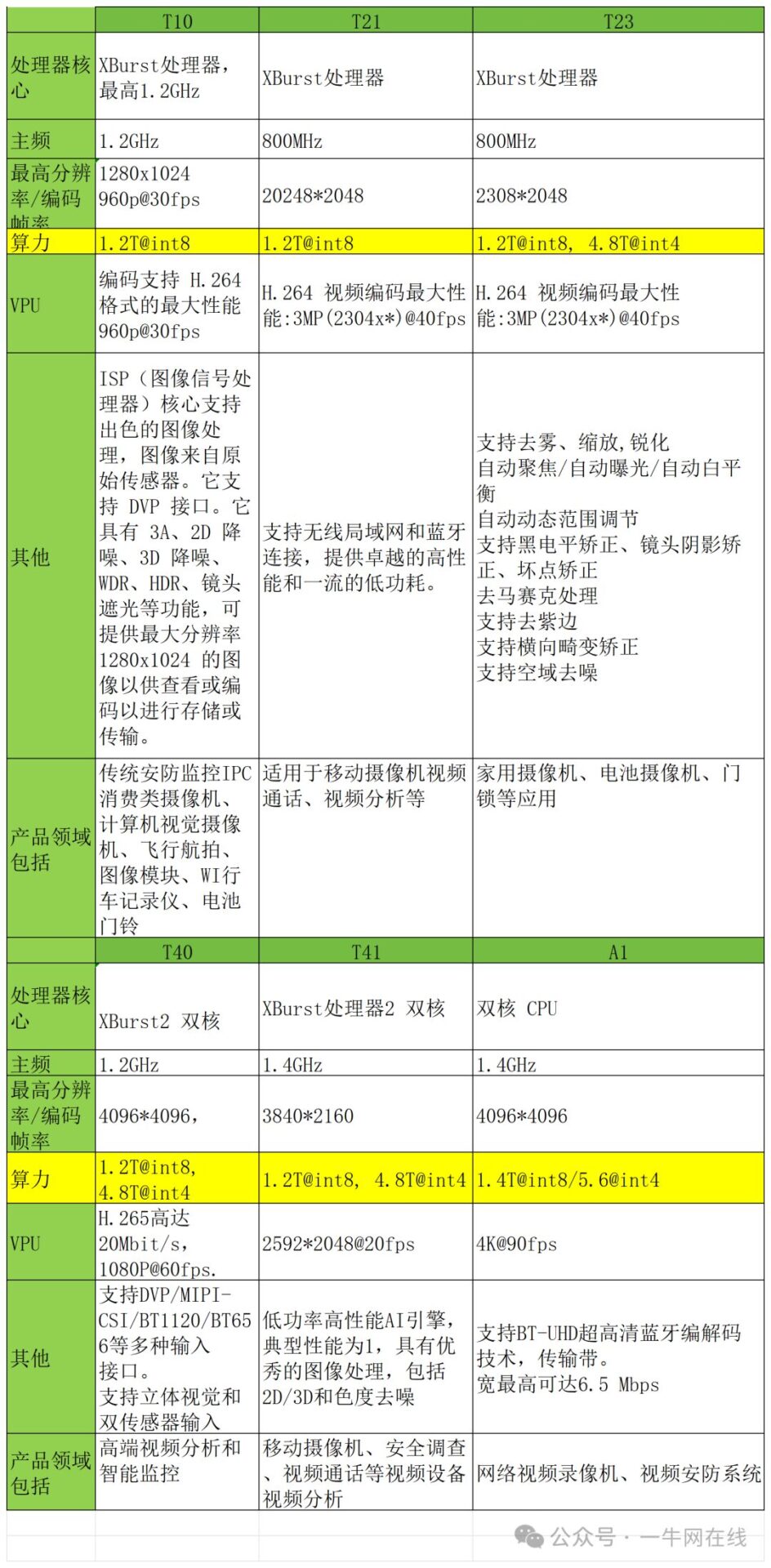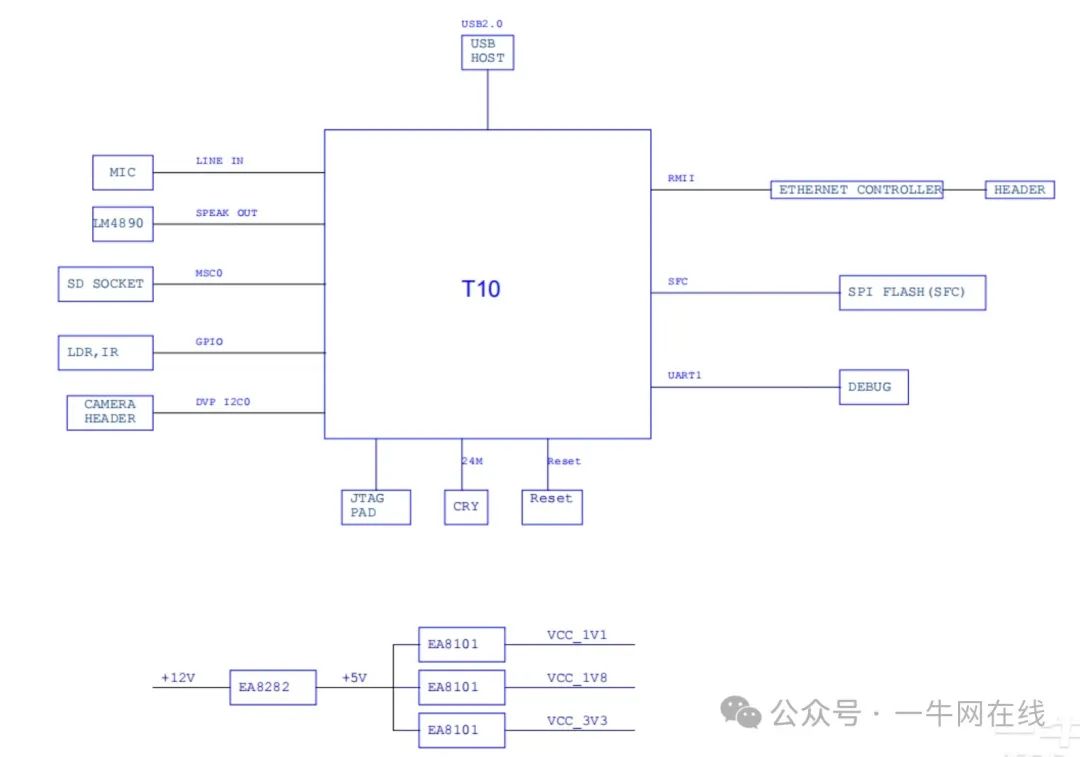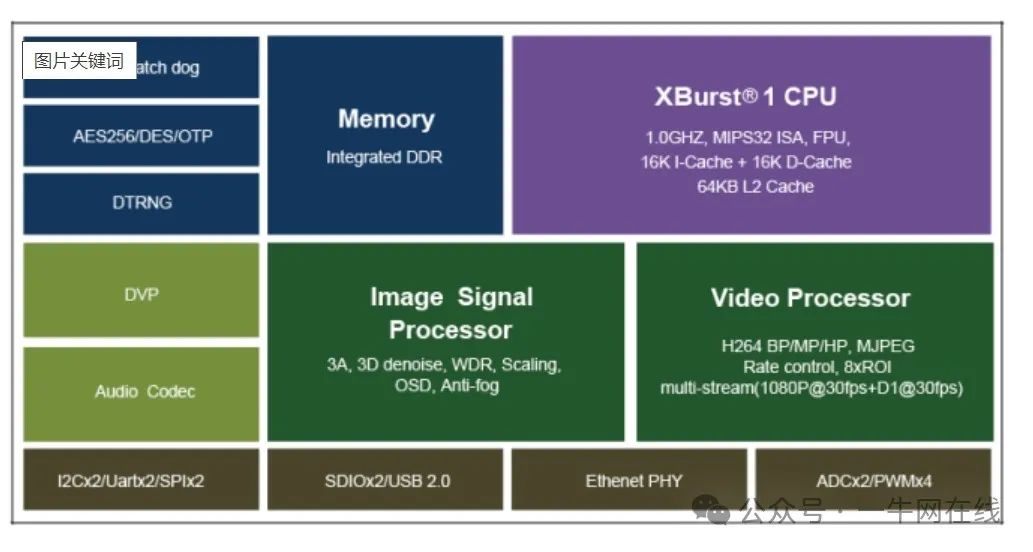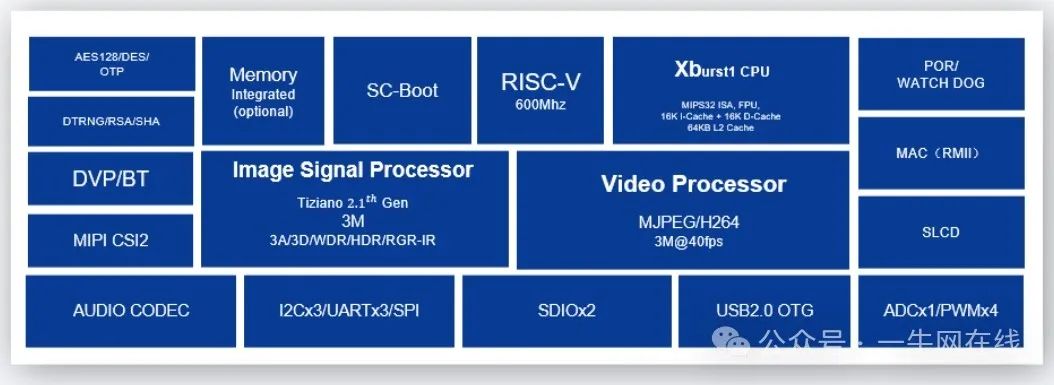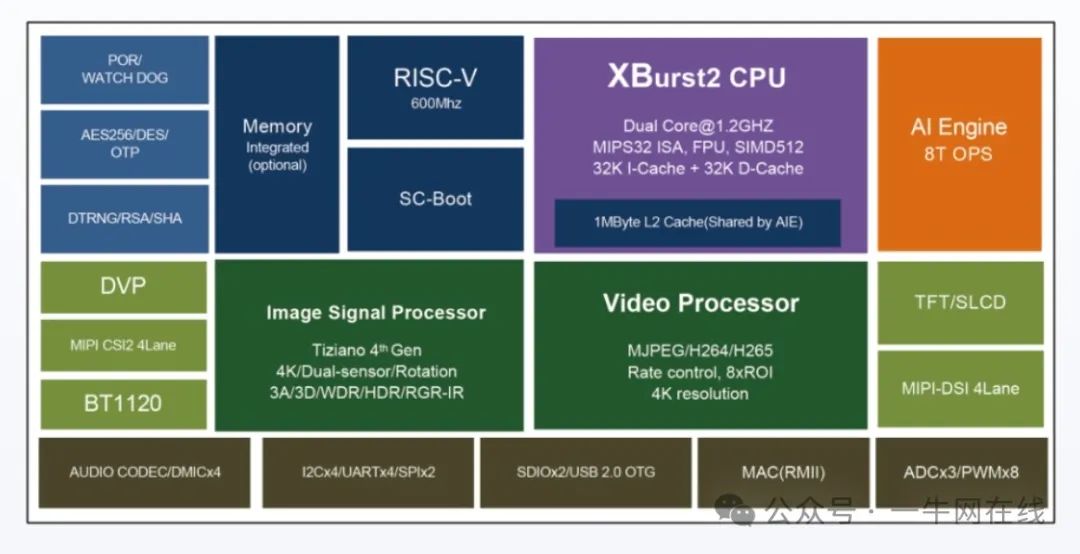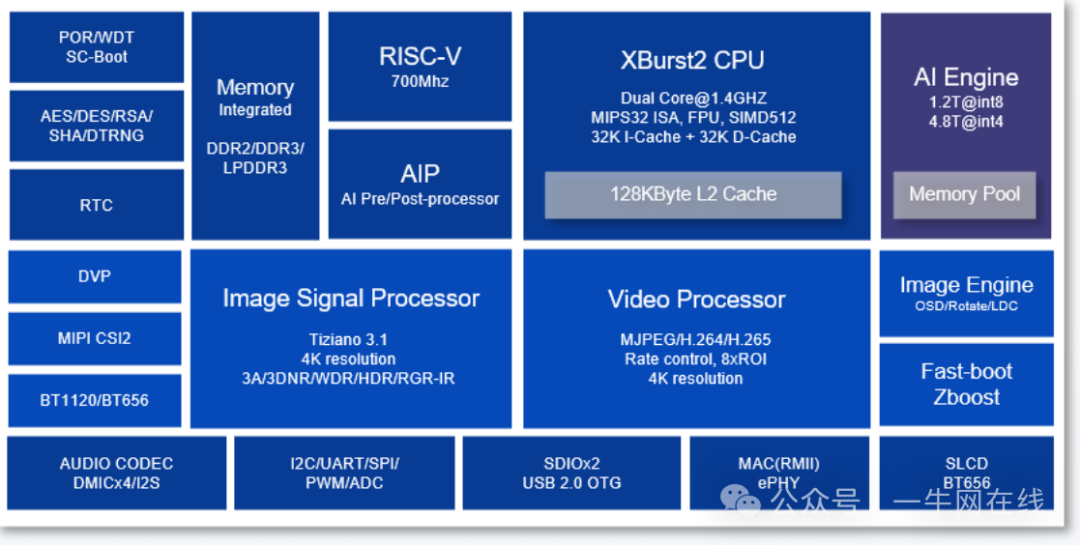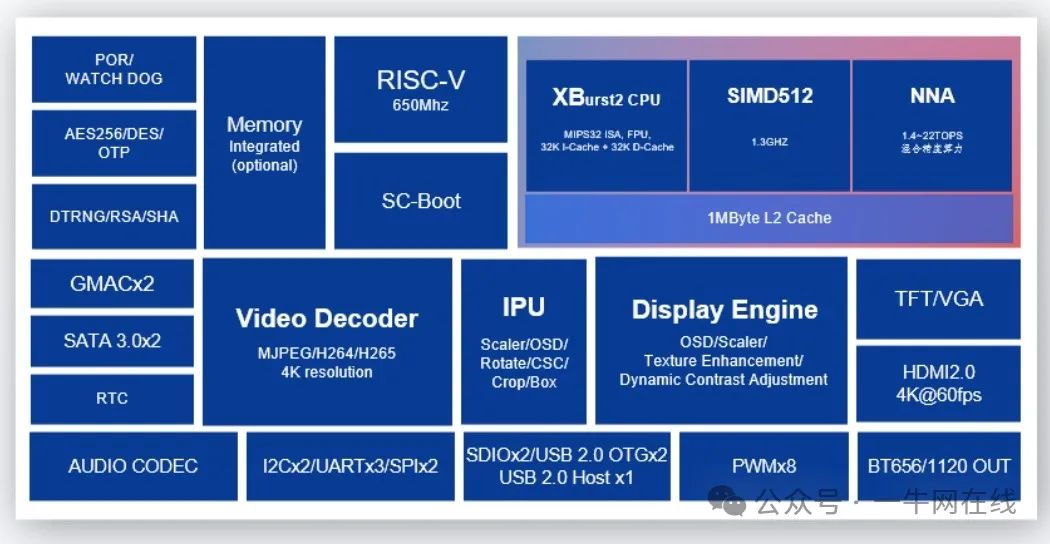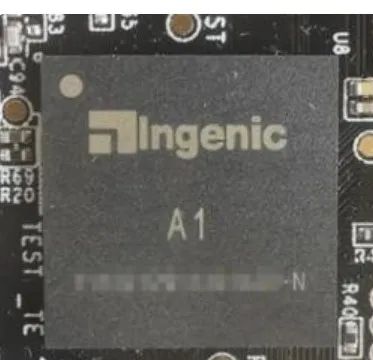Click the blue text to follow us
This is a very detailed analysis of the powerful performance exhibited by Junzheng’s series of chips in various fields, with detailed analysis of models such as T10, T21, T23, T40, and A1.
For more detailed specifications, please check with us!
The T10 integrates XBurst, ultra-low power CPU technology, and the IngenT10 intelligent video processor, focusing on high-performance computing and image video processing for mobile multimedia devices.
MXU2.0 (SIMD 128) instruction set, operating frequency 1.0-1.2GHz, low power consumption.
Equipped with 32kB instruction cache, 32kB data cache, and 128kB L2 cache.
Full-featured MMU and IEEE754 compatible hardware floating-point unit.
Video Processing Capability:
VPU core supports H.264 encoding, with a maximum resolution of 1280×1024.
Can simultaneously support 720P@30fps and VGA@30fps encoding.
ISP core supports 3A, 2D and 3D noise reduction, WDR/HDR and other image optimization functions.
Supports image input with a maximum resolution of 1280×1024.
Peripheral Interfaces and Functions:
Integrated audio codec, 64MB DDR2 memory.
Supports high-speed SPI and MMC/SD/SDIO expansion, suitable for wireless connection modules such as WLAN and Bluetooth.
Mobile cameras, security monitoring, video calls, and analysis devices.
The T21 is designed for intelligent video applications, targeting the entry-level market.
XBurst core, frequency 800MHz, 16kB instruction cache and 16kB data cache.
Equipped with 64kB L2 cache and complete MMU functionality.
Video Processing and Image Optimization:
ISP supports 2048×2048 resolution, with WDR, HDR, lens correction and other functions.
VPU core supports H.264 encoding to meet efficient video processing needs.
Integrated DDR memory and audio codec, supporting various wireless connection expansion modules.
Entry-level video analysis, security investigation devices, and video call terminals.
The T23N focuses on efficient video processing and diverse application needs.
XBurst – 1-core CPU, frequency 1.2-1.4GHz, 64kB L2 cache.
Integrated 600MHz RISC-V coprocessor, supporting RV32IM instruction set.
Video Processing Capability:
Supports H.264 encoding, performance up to 3MP@40fps.
Supports a maximum of 12bit RAW and YUV422 8bit input.
ISP maximum input resolution 2308×2048, supporting dehazing, sharpening, and scaling functions.
Built-in audio system, supporting AES, DES, RSA and other hardware encryption modules.
Rich storage and expansion interfaces, supporting applications such as home cameras and battery devices.
PU Performance Image Related Functions:
T40: ISP supports 3840×2160 resolution, with various image correction and optimization functions.
T41: ISP core supports HDR/WDR, lens correction, and other advanced functions; both have unique characteristics in image correction optimization, but specific functional coverage details are not compared in detail, making it difficult to determine superiority.
AI and Peripheral Integration
T40: Neural network accelerator typical performance 8TOPS.
T41: Has 1.2TOPS@int8 computing power for various precision AI inference; the former’s AI computing power is significantly stronger, providing an advantage in complex AI task scenarios that require high computing power.
Peripheral Integration Modules:
T40: Integrated high-speed SPI, USB OTG, and DDR2 KGD modules.
T41: Integrated DDR2 KGD, audio codec, and high-speed SPI; the latter adds an audio codec, providing unique advantages in audio-related processing, while the former has a USB OTG module, offering convenience in external device connection and expansion.
T40: Suitable for high-end cameras, video analysis, and multi-channel video devices.
T41: Suitable for video monitoring, intelligent video analysis, and high-end terminal devices; the applicable scenarios overlap to some extent, but the former focuses more on high-end cameras and multi-channel video devices, while the latter leans towards conventional video monitoring and high-end terminal devices overall.
Video Encoding Standards and Resolution Frame Rate Support:
T40: VPU supports HEVC/H.264/JPEG standards, with a resolution of up to 4096×4096, with no frame rate limitations mentioned.
T41: VPU supports HEVC/H.264 encoding, with a maximum resolution of 3840×2160 and limited to 20fps; the former has advantages in resolution and frame rate support, able to meet higher resolution and potentially higher frame rate video processing needs.
Beijing Junzheng’s first NVR chip, Junzheng A1, adopts a 1.4GHz dual-core CPU, supporting 4K@90fps decoding, 4K native display, dual Gigabit Ethernet ports, dual SATA, and other core capabilities. Targeting the security industry’s continuous upgrade of AI,
A1 has built-in 1.4T@int8/5.6@int4 AI computing power, meeting the demand for simultaneous video structuring, detection, and recognition across multiple video sources. In addition, A1 integrates key peripherals such as DDR, RTC, and Audio, greatly optimizing product implementation costs.
Utilizing the integrated advantages in Magik, with 1.4T@int8/5.6@int4 computing power, centralized recognition, secondary detection, and video element retrieval can be implemented as backend functions. Combined with the intelligent capabilities of Beijing Junzheng’s front-end T series chips, a distributed AI security system with coordinated front and back ends can be easily created.
Junzheng A1 will provide different tiers of chips based on different application positioning, meeting the development needs of low, medium, and high-end NVR products. In addition to supporting traditional requirements such as ultra-large capacity disk slots and ultra-high-definition decoding, it also supports mainstream industry categories such as Wi-Fi kits and POE; moreover, leveraging Junzheng’s advantages in front-end intelligence and low power consumption, A1 also covers emerging forms such as low-power base stations, NAS, and smart light screens.
In addition, Junzheng’s series of chips, with their powerful performance in CPU, VPU, ISP, AI engine, and rich peripherals and interfaces, have significant application value in various fields such as video processing, security monitoring, industrial control, and the Internet of Things, meeting the high-performance and low-power chip needs of different industries.
Custom Development of MTK Dimensity 9400/8300/9000/9200/9300 PoP Process
Comprehensive Comparison of Junzheng AI Chip Performance (1) – T31 Series vs T41 Series
SigmaStar Low Power Series Chip AI Performance Comparison
SigmaStar Low Power Series Chip AI Performance Comparison (2)
RV1103/1106/1109/1126 & RK3562/3568/3576/3588 AI Performance Parameter Selection
Hi3516/3519/3559/3403 AI Performance Parameter Selection
T40 + OS08A20 4K 8 million (4G version & non-4G version) license plate recognition module
T40 development board (AI recognition) module/solution customization
T40 development board/solution customization
T40XP + OS08A20
T40 vehicle DVR 4-channel 720p AHD solution/customization/replacement of Hi3520 series
T40 NOR quick-start AI camera/solution customization
Junzheng A1 33-channel (dual Ethernet port) streaming device
Junzheng A1 embedded NVR function board
Junzheng A1 full HD network video decoder/solution customization
RK& Allwinner & Hisilicon Decoding Solutions
Rockchip RK3399 Android Smart Mainboard
Rockchip RK3288 Android 8.1 10.1-inch dual-screen smart interactive digital signage
Rockchip RK3288 wall-mounted WeChat face payment module
Hi3516AV100 core board development board
Hisilicon Hi3516EV300 development board/core board
SigmaStar 120 frames high frame rate smart network camera Wi-Fi module
SigmaStar SSD268G 12 million low-light smart HD network camera module
SigmaStar SSC377D 5 million black light full-color smart HD network camera module
Hisilicon & RK AI Perspective Solutions
Hisilicon Hi3520 single-channel SDI input HDMI output encoding board
Hisilicon Hi3520 single-channel SDI input HDMI output encoding board
What is Yiniu Network about? Let us introduce Yiniu Network in 1 minute!
For more information, please click the link above or add the WeChat below, thank you for your attention!
Long press the QR code to add WeChat
Join the AI technology group


